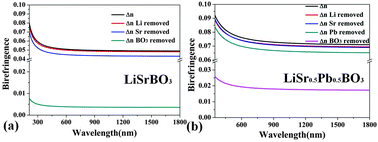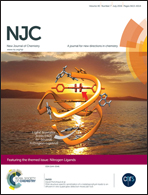Manipulation of birefringence via substitution of Sr2+ by Pb2+ based on the structure model of LiSr1−xPbxBO3 (0 ≤ x ≤ 0.5)†
Abstract
A series of LiSr1−xPbxBO3 (x = 0.138, 0.285, 0.320, 0.379, 0.417, and 0.5) crystals have been obtained through a high-temperature solution reaction with spontaneous nucleation technique, and the crystal structures were solved from single-crystal X-ray diffraction data. Through a great deal of experiments, it was determined that the maximum value of x cannot be greater than 0.5 possibly because the Sr/Pb–O bond length and the equivalent isotropic displacement parameter of O(3) atoms continuously increased with the increased ratio of Pb2+ cations. It is found that when the Sr atoms were partially substituted with Pb atoms with optical anisotropies, the birefringence improved from 0.0494 at 1064 nm in LiSrBO3 to 0.0721 at 1064 nm in LiSr0.5Pb0.5BO3. Based on the first-principles and real-space atom-cutting method, the origin of birefringence was attributed to the Pb2+ cations and (BO3)3− groups in LiSr0.5Pb0.5BO3. The infrared spectrum properties and thermal behavior were also reported.


 Please wait while we load your content...
Please wait while we load your content...